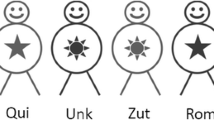Abstract
Although echoic prompts may be effective for teaching intraverbal behavior to children with autism, the performance of some children may become dependent on such prompts (i.e., the prompts cannot be eliminated). Recent research suggests that visual rather than echoic prompts may be used to teach children with autism a variety of skills and may facilitate independent performance. In the present study, an adapted alternating treatments design was used to compare the effects of using visual (textual) and echoic prompts on acquisition of intraverbal responses (answering questions) by 2 children with autism. The results indicated that the textual prompts were more effective than the echoic prompts. Implications for the use of visual prompts during instruction with children with autism are discussed.
Similar content being viewed by others
References
Bondy, A., & Frost, L. (1994). The picture exchange communication system. Focus on Autistic Behavior, 9, 1–19.
Charlop-Christy, M. H., Le, L., & Freeman, K. A. (2000). A comparison of video modeling with in vivo modeling for teaching children with autism. Journal of Autism and Developmental Disorders, 30, 537–552.
Finkel, A. S., & Williams, R. L. (2001). A comparison of textual and echoic prompts on the acquisition or intraverbal behavior in a six-year-old boy with autism. The Analysis of Verbal Behavior, 18, 61–70.
Goldsmith, T. R., LeBlanc, L. A., & Sautter, R. A. (2007). Teaching intraverbal behavior to children with autism. Research in Autism Spectrum Disorders, 1, 1–13.
Leaf, R., & McEachin, J. (Eds.). (1999). A work in progress: Behavioral management strategies and a curriculum for intensive behavioral treatment of autism. New York: DRL Books.
MacDuff, G. S., Krantz, P. J., & McClannahan, L. E. (1993). Teaching children with autism to use photographic activity schedules: Maintenance and generalization of complex response chains. Journal of Applied Behavior Analysis, 26, 89–97.
McClannahan, L. E., & Krantz, P. J. (1997). In search of solutions to prompt dependence: Teaching children with autism to use photographic activity schedules. In D. M. Baer & E. M. Pinkston (Eds.), Environment and behavior (pp. 271–278). Boulder, CO: Westview.
Partington, J. W., & Sundberg, M. L. (1998). Teaching language to children with autism or other developmental disorders. Pleasant Hill, CA: Behavior Analysts, Inc.
Pierce, K. L., & Schreibman, L. (1994). Teaching daily living skills to children with autism in unsupervised settings through pictorial self-management. Journal of Applied Behavior Analysis, 27, 471–481.
Quill, K. (1997). Instructional considerations for young children with autism: The rationale for visually-cued instruction. Journal of Autism and Developmental Disabilities, 27, 697–714.
Savner, J. L., & Myles, B. S. (2000). Making visual supports work in the home and community: Strategies for individuals with autism and Asperger syndrome. Shawnee Mission, KS: Autism Asperger Publishing.
Schmit, J., Alper, S., Raschke, D., & Ryndak, D. (2000). Effects of using a photographic cueing package during routine school transitions with a child who has autism. Mental Retardation, 38, 131–137.
Sindelar, P. T., Rosenberg, M. S., & Wilson, R. J. (1985). An adapted alternating treatments design for instructional research. Education and Treatment of Children, 8, 67–76.
Tissot, C., & Evans, R. (2003). Visual teaching strategies for children with autism. Early Child Development and Care, 173, 425–433.
Touchette, P. E. (1971). Transfer of stimulus control: Measuring the moment of transfer. Journal of the Experimental Analysis of Behavior, 15, 347–354.
Williams, G., Carnerero, J. J., & Perez-Gonzalez, L. A. (2006). Generalization of tacting actions in children with autism. Journal of Applied Behavior Analysis, 39, 233–237.
Williams, G., Donley, C. R., & Keller, J. W. (2000). Teaching children with autism to ask questions about hidden objects. Journal of Applied Behavior Analysis, 33, 627–630.
Author information
Authors and Affiliations
Corresponding author
Additional information
This report is based on a thesis submitted by Laura Meunier to the Department of Counseling Psychology, Rehabilitation, and Special Education, Northeastern University, Boston.
Rights and permissions
About this article
Cite this article
Vedora, J., Meunier, L. & Mackay, H. Teaching Intraverbal Behavior to Children with Autism: A Comparison of Textual and Echoic Prompts. Analysis Verbal Behav 25, 79–86 (2009). https://doi.org/10.1007/BF03393072
Published:
Issue Date:
DOI: https://doi.org/10.1007/BF03393072




